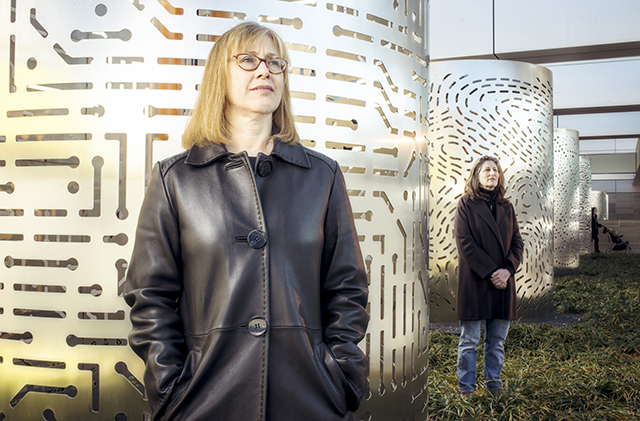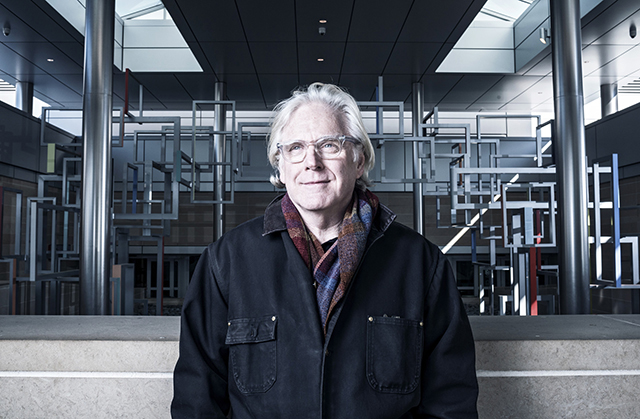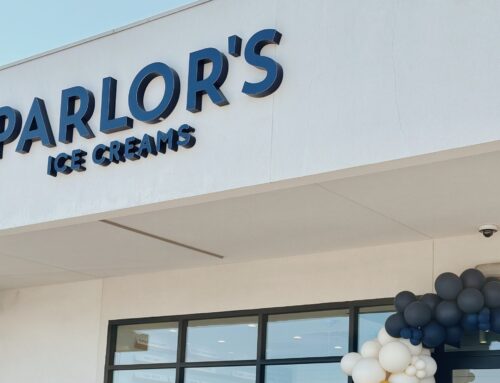
Diana Goldberg and Julie Cohn created Luminania, which are six 10-foot-tall stainless steel cylinders with flight-related designs pierced into the metal: Danny Fulgencio
Long before travelers pull up to the front doors of Dallas Love Field, they can catch a glimpse of the artwork of two East Dallas artists, glowing like beacons in the night, welcoming them to the entrance of the airport.
Luminaria, the name of the public art project outside the front doors of Love Field, consists of six 10-foot tall stainless steel cylinders, each featuring a different flight-related design pierced into the metal, through which a warm central light shines brightly.
Behind the project, Intersected Passage, another public art project created by an East Dallas artist, stretches over the walkway, ushering guests inside the glass doors.
In recent years, Dallas Love Field has undergone a major remodel and expansion in order to prepare for the impending lift of the Wright Amendment in October 2014, which will allow Southwest Airlines to fly nonstop to anywhere in the United States and inevitably will increase traffic through Dallas Love Field Airport.
When mapping out the structure, Love Field left room for 11 new public art projects. Although Love Field kept much of the original artwork from before the remodel, they also wanted to add new pieces to the collection, to represent both the “proud past” of the airport and the “diverse future,” according to a video on the Love Field website.
In 2009, Love Field partnered with the Office of Cultural Affairs and the Public Art Program to find artists — in Dallas, from elsewhere in Texas or beyond — who could create artwork that embraced themes of flight and the history of Dallas and Love Field Airport. Although artists from all over the world applied, many of the artists emerged from Dallas’ own backyard, including three East Dallas artists — Diana Goldberg, Julie Cohn and Tom Orr.
Luminaria
Diana Goldberg and Julie Cohn, the artists who created Luminaria, met in 2008 while working on a public art project for DART. Later, when they caught wind of the call for public art at Love Field, they joined forces on a project.
They submitted their portfolios for review and were chosen as potential candidates for the two large spaces out front. In order to secure the position, they had to compete against several other artists for the same space. All the artists spent months brainstorming, researching and creating a design for the appointed space, which they then presented to the Love Field Art Program in a slideshow. Goldberg and Cohn’s design was dubbed the favorite, and they began working with fabricators and engineers to produce their concept — Luminaria.
Goldberg’s background is in painting, printmaking and design. She received her Bachelor of Fine Arts from Miami University, and she often works with her husband, Brad Goldberg, on public art projects. Their work can be found throughout the United States, as well as in Europe and Asia.
Cohn trained as a painter and printmaker. She received her Masters of Fine Arts in Painting and Printmaking from Southern Methodist University. Her creative path includes work in jewelry, textiles and wall coverings, as well as collaborations in architecture and public art.
Because both artists’ work relies heavily on patterns and textures, creating sculptures that feature various patterns and designs was a natural fit for them.
At first, they expected to get one of the inside spaces where they could create a terrazzo piece, but when they were appointed the front-and-center spaces outside, they had to reroute their thinking. It was a little problematic because the available space was so large and split into two, forcing them to create multiple sculpture pieces on a somewhat constraining budget, they say. They also realized the scale needed to be oriented for both pedestrians walking by and for drivers dropping off travelers at the front door.
“Since it’s the entrance, and since sometimes travel is stressful and travelers are coming into your city, we were very interested in creating something welcoming and warm,” Goldberg says.
The pair spent hundreds of hours researching flight and the history of Love Field and Dallas. They looked at anything related to airports or flight with new eyes. Charts, maps, runway lights, pieces of airplanes, old stewardess outfits —everything became grist for the mill of inspiration.
“We did this sort of scattershot, where we pinned all this research up on the wall,” Cohn explains.
They also looked at the contributions Dallas has made to the world of art and technology, as well as the history of Love Field as being on the cutting edge of technology, innovation and design.
“When we were looking at all this stuff — all the charts, weather maps and flight patterns — all of it was very visually complicated,” Goldberg says. “We decided we liked all the patterns, and we wanted to create patterns that combined this idea of technology and art.”
“Also, Luminaria being from the Southwest lent itself to the idea,” Cohn added. “We wanted it to be like giant night-lights.”
The name “Luminaria” refers to lanterns, usually made out of a candle placed on top of sand inside a paper bag, that are sometimes seen in the Southwest around Christmastime.
Each sculpture has a pattern pierced into the side that represents a different concept: computers, weather and mapping, the routing system, thermodynamics, Bernoulli’s principle and subatomic physics.
“Everything about it is very considered,” Cohn says.
“We know a lot more about flight than we did,” Goldberg adds, laughing.
Intersected Passage

East Dallas artist Tom Orr pulled from his personal memories of Dallas Love Field when he created his piece, Intersected Passage: Danny Fulgencio
East Dallas artist Tom Orr pulled from his personal memories of Dallas Love Field when he created his piece, Intersected Passage.
The 17-foot, multicolored aluminum structure that arches over the walkway leading up to the airport terminal was inspired by the original 1958 entrance sign to Dallas Love Field Airport (which recently was pulled out of storage and erected at the corner of Mockingbird and Cedar Springs).
“I always loved that sign,” he says.
Like the sign, his piece is made of hard right angles and bold blocks of color. Unlike the sign, however, Orr’s artwork incorporates mirrors to give the impression the piece is folding in on itself in some places.
“Light and shadow are primary elements of my work,” Orr says in his bio. “I am particularly interested in illusions created by using line and light, repetition and staggered order to create visual movement and patterns.”
Orr was originally asked to design for a space inside the airport, but his first draft was too complex. With all the hard angles, Love Field was afraid it could be a safety hazard.
He says he felt confident about the piece and was disappointed when he didn’t get the commission, but the next day Love Field called back and asked if he could rework the piece for a different space outside.
“That never happens,” Orr says, laughing. He agreed and set to work creating a new model.
“I did have to work with engineers and change a few things, but it’s still pretty much exactly what I wanted to do,” he says. “In reality, the engineer was so good, it looks even better than I’d envisioned.”
Putting it all together was another story. The archway had to be disassembled into 17 pieces and brought in section by section. Under Orr’s supervision and with the help of detailed, color-coated plans, a skilled team put everything together in a few weeks.
“I was very, very pleased with how it turned out,” he says.
Orr also has pieces at DFW Airport, in corporate art collections in Dallas, and at museums in Japan. He received his Bachelor of Fine Arts from Rhode Island School of Design and exhibits his work at Barry Whistler Gallery in Deep Ellum.
He’s also the artist who in 2001, along with his wife, Frances Bagley, designed the White Rock Lake Water Theater, where a variety of birds like to perch to bask in the sun behind the Bath House Cultural Center.
City of Dallas public art manager Kay Kallos says the board that chose the artists originally hoped at least 25 percent of the artists would be from Dallas. However, 45 percent of the artists chosen were Dallas-based.
“The reason why we ended up going over our original 25 percent was because the Dallas artists competed very strongly against the other national and international artists,” she explains.
“Many of the Dallas-based artists who were chosen are working all over the world. They’re competing on a global scale. We chose them not because they were Dallas artists, but because their work was extremely strong and appropriate for the location.”





